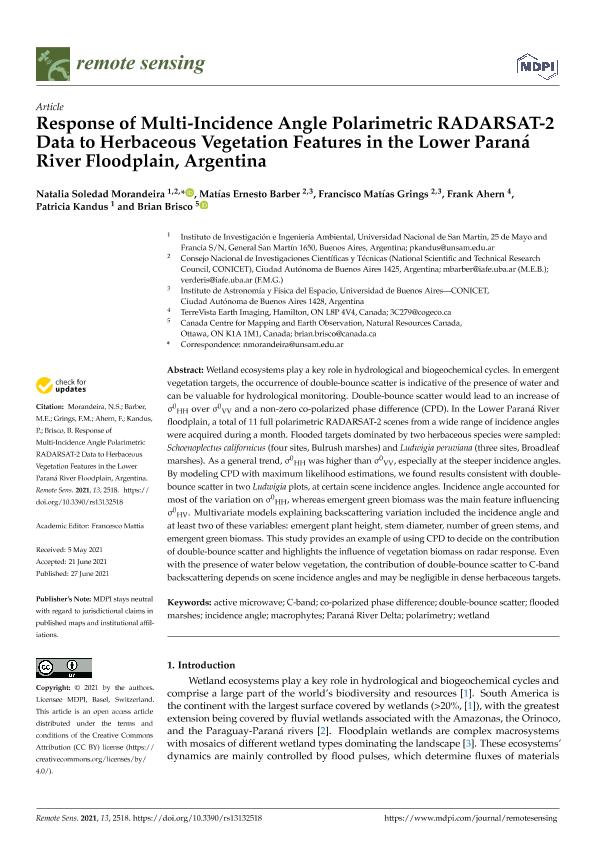Artículo
Response of multi-incidence angle polarimetric RADARSAT-2 data to herbaceous vegetation features in the lower Paraná river floodplain, Argentina
Morandeira, Natalia Soledad ; Barber, Matias Ernesto
; Barber, Matias Ernesto ; Grings, Francisco Matias
; Grings, Francisco Matias ; Ahern, Frank; Kandus, Patricia; Brisco, Brian
; Ahern, Frank; Kandus, Patricia; Brisco, Brian
 ; Barber, Matias Ernesto
; Barber, Matias Ernesto ; Grings, Francisco Matias
; Grings, Francisco Matias ; Ahern, Frank; Kandus, Patricia; Brisco, Brian
; Ahern, Frank; Kandus, Patricia; Brisco, Brian
Fecha de publicación:
06/2021
Editorial:
Multidisciplinary Digital Publishing Institute
Revista:
Remote Sensing
e-ISSN:
2072-4292
Idioma:
Inglés
Tipo de recurso:
Artículo publicado
Clasificación temática:
Resumen
Wetland ecosystems play a key role in hydrological and biogeochemical cycles. In emergent vegetation targets, the occurrence of double-bounce scatter is indicative of the presence of water and can be valuable for hydrological monitoring. Double-bounce scatter would lead to an increase of σ0 HH over σ0 VV and a non-zero co-polarized phase difference (CPD). In the Lower Paraná River floodplain, a total of 11 full polarimetric RADARSAT-2 scenes from a wide range of incidence angles were acquired during a month. Flooded targets dominated by two herbaceous species were sampled: Schoenoplectus californicus (four sites, Bulrush marshes) and Ludwigia peruviana (three sites, Broadleaf marshes). As a general trend, σ0 HH was higher than σ0 VV, especially at the steeper incidence angles. By modeling CPD with maximum likelihood estimations, we found results consistent with double-bounce scatter in two Ludwigia plots, at certain scene incidence angles. Incidence angle accounted for most of the variation on σ0 HH, whereas emergent green biomass was the main feature influencing σ0 HV. Multivariate models explaining backscattering variation included the incidence angle and at least two of these variables: emergent plant height, stem diameter, number of green stems, and emergent green biomass. This study provides an example of using CPD to decide on the contribution of double-bounce scatter and highlights the influence of vegetation biomass on radar response. Even with the presence of water below vegetation, the contribution of double-bounce scatter to C-band backscattering depends on scene incidence angles and may be negligible in dense herbaceous targets.
Archivos asociados
Licencia
Identificadores
Colecciones
Articulos(IAFE)
Articulos de INST.DE ASTRONOMIA Y FISICA DEL ESPACIO(I)
Articulos de INST.DE ASTRONOMIA Y FISICA DEL ESPACIO(I)
Articulos(SEDE CENTRAL)
Articulos de SEDE CENTRAL
Articulos de SEDE CENTRAL
Citación
Morandeira, Natalia Soledad; Barber, Matias Ernesto; Grings, Francisco Matias; Ahern, Frank; Kandus, Patricia; et al.; Response of multi-incidence angle polarimetric RADARSAT-2 data to herbaceous vegetation features in the lower Paraná river floodplain, Argentina; Multidisciplinary Digital Publishing Institute; Remote Sensing; 13; 13; 6-2021; 1-17
Compartir
Altmétricas



